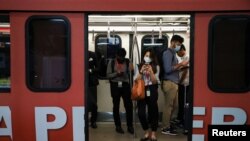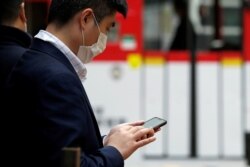Using geotagged tweets, researchers were able to predict, within a few kilometers, where the first coronavirus case in the United Kingdom would appear.
"When we saw the map for the first time, I can tell you that we were kind of shocked," Donal Bisanzio, senior epidemiologist at RTI International and co-author of the study, said.
The research is preliminary, and other experts have not yet reviewed it for accuracy. But it's one example of how public health experts are using tracking data from mobile phones to respond to outbreaks like the coronavirus spreading from Wuhan, China.
Experts say privacy concerns are likely to take a back seat to public health when facing a virus that has sickened more than 40,000 people and killed more than 1,000.
Unprecedented detail
When authorities want to know where a contagious disease will go, they need to know where people go.
Mobile phone data offer an unprecedented view, Andy Tatem, a University of Southampton demographer and epidemiologist, said.
"To have such geographical scale and such detailed time resolution, we've never been able to do that before until mobile phone data sets came along," he said.
RTI's Bisanzio and colleagues had collected a tranche of geotagged tweets from 2013 to 2015 for another project. When the coronavirus outbreak hit, he said, "We just thought, maybe we can use this. Even if we don't have a lot of people, let's try. Let's see if we have something or not."
They identified about 160 users who tweeted first from Wuhan and then from another city. Most traveled within China. But five of those who left the country turned up in the U.K., suggesting that the country is a fairly popular destination for travelers from Wuhan.
The day Bisanzio posted the study, the U.K. announced its first cases of coronavirus.
Are you ready?
In addition, 10 Twitter users from Wuhan appeared in cities in the United States, including near Seattle, Los Angeles and Tucson, Arizona. All of those cities have reported coronavirus cases.
Though the tweets and the coronavirus cases were separated by years, three-quarters of the posts came from within 15 kilometers of where a coronavirus patient later turned up. Travel patterns did not change much in that time, he said.
Bisanzio cautioned that just because a traveler from Wuhan showed up in a city six years ago, "that doesn't mean that you have high risk of getting the virus."
"But, of course," he added, "it also means, be careful. Are you sure that your country is ready?"
For the past decade or so, researchers have been using mobile phone data to draw detailed maps of where and when people travel, whether it's between countries or within cities. They're generally not looking to track individual people. Rather, they aim to understand broad patterns and pathways of population movement.
This information has helped scientists understand the spread of rubella in Kenya, dengue in Singapore and Ebola in West Africa, among others.
In an outbreak like the Wuhan coronavirus, "where you're trying to design a strategy to contain it and stop it from spreading, then movement (data) becomes really vital," demographer Tatem said. Phone data "is a really valuable data source that we haven't had before."
Surveillance state
Researchers are required to strip identifying information out of the data before they work with it, and the data is often a year or more old.
In China, however, authorities are using mobile phone information as well as facial recognition software to monitor individual patients and suspected cases in real time, according to The Wall Street Journal.
Officials tracked one infected person across the city of Nanjing minute by minute and published the details of the patient's travels on social media to warn residents that they may have been infected if they crossed paths.
"We're at an interesting moment," said Steve Feldstein, an expert on technology and repression at Boise State University and a nonresident fellow at the Carnegie Endowment for International Peace.
While China's surveillance state is generally considered a tool of repression, "the same set of systems can provide a lot of useful, granular, real time information when it comes to the spread of a very fast moving and unsettling epidemic," he said.
Liberty vs. health
In the United States, experts say mobile phone data would likely be fair game for public health and law enforcement officials if the outbreak were to spread here.
The U.S. Supreme Court has ruled that officials need a really good reason to collect that data, given how sensitive it is.
"You're contemplating a potential deprivation of liberty" for the person whose data is being collected, said Sharon Bradford Franklin, policy director of the Open Technology Institute at New America, a policy research organization. "You could have your travel restricted, you could be under quarantine, which is a real deprivation of liberty, just like being locked up in jail."
"A public health crisis, like this coronavirus seems to be, might provide the sufficient compelling public interest," she added, but there would need to be strong limits on who could access the data and why, and limits on how long officials could hold onto it.
"You might want to permit it, but only with justification and with robust safeguards," Franklin said.










